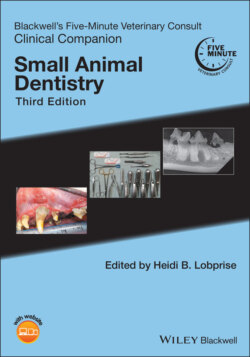Читать книгу Blackwell's Five-Minute Veterinary Consult Clinical Companion - Группа авторов - Страница 18
EQUIPMENT
ОглавлениеRadiographic unit (Figure 3.1)A dental radiographic unit at the dental station provides convenience to take intraoral radiographs of every patient: this can be wall‐mounted, on a movable stand, or hand‐held units.Cone beam computed tomography (CBCT)Three‐dimensional view (voxels) of the hard tissues with less patient and operator radiation exposure [3].Soft tissues imaged with high‐definition volumetric imaging (HDVI).*90–1000 μm resolution depending on selected system capability.Figure 3.1 Radiographic generators: examples of wall‐mounted (left) and hand‐held (center) dental radiographic generators. Always stand at least 6 feet (2 meters) away from the beam and/or 270° to the side. (Right) Example of a cone beam computed tomography (CBCT) unit. Some units allow only extremities to be imaged. Others can image all body areas and more than hard tissue.
Intraoral films (no. 2 and no. 4 common sizes)Require development: chairside or automatic developer.Time lapse before images can be viewed on view box.Retakes due to inexperience or exposure adds to anesthetic time.
Digital intraoral radiography (Figure 3.2)Direct digital radiography with solid‐state sensor:Sensor typically size no. 2, similar to no. 2 periapical intraoral film.Allows immediate review of image for adjustments.Sopix sensor has widest latitude of exposure, minimizing retakes [4].Sensor may be expensive to replace.Indirect digital radiography:Phosphor plates allow for additional sizes such as no. 4 for larger view.Takes additional time to scan the phosphor plate in order to view the image and retake to adjust for positioning or exposure.
Cone beam computed tomography (three‐dimensional imaging) (Figure 3.3)Complete a full mouth (skull) scan in as little as 24 seconds, minimizing anesthesia [3].Visualize three‐dimensional structures without obstruction such as maxillary architecture.Confirm periapical changes, tooth resorption, and temporomandibular joint (TMJ) architecture earlier, with 50% more sensitivity [5,6].Image pulmonary nodules as small as 1 mm, which is up to nine times smaller than nodule detection using three‐dimensional thoracic radiography [7].Find twice as many traumatic injuries as missed with conventional radiology [8].
Figure 3.2 (Left) No. 4 (occlusal) and no. 2 (periapical) phosphor plates for use in indirect digital radiology. The sizes are similar to commonly used nondigital intraoral films. (Right) Sopix digital sensor, similar to no. 2 size of intraoral dental film.
Figure 3.3 Example images acquired in a CBCT scan: (a) sagittal, (b) axial, and (c) coronal “slices”; (d, e) three‐dimensional reconstructions for viewing. Maxillary obscured periapical and periodontal disease in the 200 quadrant is revealed.
